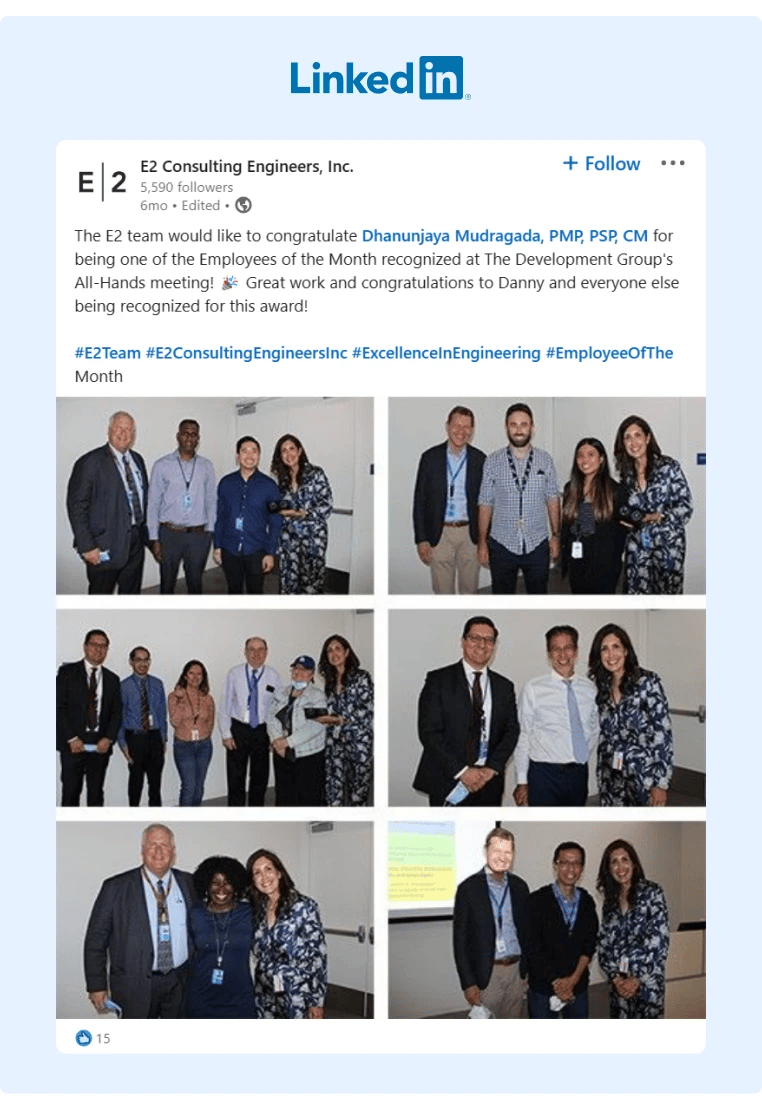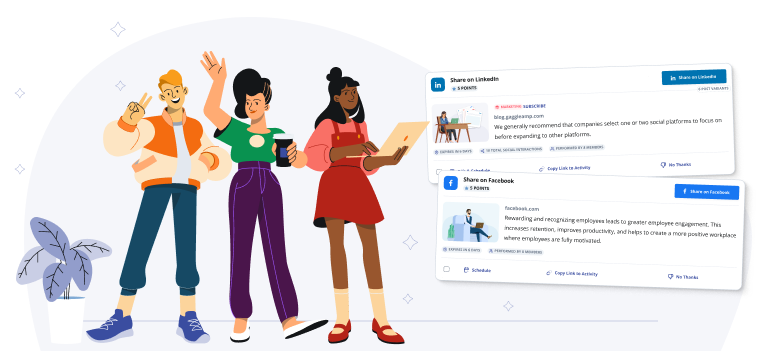Creating a Culture of Sharing That Fuels Collaboration
In an era of quiet quitting, many companies are scrambling to uncover the reason why. For some employees, the disengagement and subsequent resignation is driven by lackluster salary and benefits, but for others it’s the company’s culture. Specifically, the lack of workplace culture sharing.
Why is it important to share culture?
Employees don’t want to be siloed. They want clear communication, both company wide and departmental. They want to feel included and valued. By sharing workplace culture, your team gains better communication, inclusion, and value. More importantly, they gain trust with one another and the company.
Leaders are taking note of the rise of workplace culture. In fact, 67% of leaders say culture is more important to business success than strategy and operations. A DNV survey also found 88% believe a diverse and inclusive company is a better performing one. This is consistent with McKinsey’s series of reports over the years on company diversity, which have all shown that more diverse companies perform better.
Creating a culture of sharing is multi-faceted. It requires an environment where knowledge can be shared horizontally and vertically across the company. It needs diverse teams to work collaboratively, bringing together a variety of backgrounds and perspectives, to give the company a competitive edge. And that’s just one of the reasons why is it important to interact with different cultures.
Read on for a deep dive into how to share culture with others effectively.
What Is a Culture of Sharing?
So, what does a knowledge-sharing culture in the workplace look like?
Picture this: Employees walk into the office every day feeling confident and secure. During the day, collaboration and mutual assistance are commonplace, thanks to a positive work environment that encourages the sharing of information. Employees build close relationships while working together through both high-stakes tasks and casual interactions.
In a nutshell, that’s what a company with a culture of sharing looks like.
In a company with a strong workplace culture, knowledge flows seamlessly. While team members are sharing insights, executives on different levels of the hierarchy also engage with each other, welcome feedback, and openly discuss the decision-making process. Similarly, knowledge flows smoothly between different departments as well. When relevant, this knowledge sharing in companies can even benefit collaborations with industry peers.
Why Does Culture Sharing Matter?
When employees have the critical information that they need, their job performance and productivity improve, which in turn, improves long-term company growth.
But, when workplace culture sharing is poor, you run into problems like the information disasters that Johns Hopkins and NASA each faced. In both situations, they lost critical, valuable information because they didn’t have a knowledge-sharing backup in place.
Thankfully, not all companies made the same mistake as Johns Hopkins and NASA. Xerox realized that they had a poor culture of sharing and fixed it before it was too late.
Background: the company had a huge problem of knowledge-sharing between its service engineers and its massive customer service team. The company’s engineers were developing highly efficient solutions to equipment issues when dealing with customers in the field but none of these were documented. They were only being shared with the few employees in the local office.
This knowledge-sharing issue was noticed by anthropologists at Xerox’s Palo Alto Research Center, who realized how much knowledge-sharing was occurring at local offices over the breakfast table.
This changed with the creation of The Eureka Project, their knowledge management solution. Not only did this allow engineers to document and vet their solutions on a platform accessible to everyone, but it also allowed them to attach their names to articles. This increased their sense of satisfaction and encouraged participation. Since its deployment in the early 1990s, the Eureka platform has continuously evolved, saving the company an estimated $100 million.
Benefits of Knowledge Sharing
Here are a seven benefits that your company and employees can gain from knowledge-sharing:
1. Gaining a Deeper Understanding of the Company
Knowing more about the company, its processes, and its objectives can lead to better team alignment.
2. Seeing Situations From a Different Perspective
Having a diverse workplace enables employees to see situations from different perspectives. This, in turn, invites and nurtures new ideas and encourages creativity and innovation in decision-making.
3. Increased Employee Productivity and Engagement
Improved internal communication and teamwork are also core pillars of an effective marketing communication strategy and that leads to more readily available knowledge and greater overall productivity. The sharing of culture and ideas also increases employee engagement, which improves motivation and employee retention.
4. Reduced Employee Training Costs
Employees will be more educated which can reduce training costs. A great example is Toyota’s training process, which promotes knowledge transfer.
When launching a new factory, the company sends 200-300 new employees to work in an existing factory. While there, they work side-by-side with more experienced employees and study the production system.
After the initial training, the newer employees are transferred back to the new factory. They’re also accompanied by 100-200 highly experienced employees who work with them to ensure the production system is implemented into the new factory site.
5. Promotes a Culture of Learning
Studies have consistently shown that learning and development are often named as one of the top benefits employees want from an employer.
6. Creates a Psychologically Safe Workplace
This includes creating a workplace where diversity and inclusion are encouraged, another critical factor for many employees. When a workplace is safe, employees are more confident, willing to take initiative, and unafraid to ask for help.
7. Discourages Knowledge Hoarding
This means that if a key employee leaves, their knowledge won’t leave with them. Relevant information will already have a channel for distribution across the company.
Now that we know why culture sharing matters, let’s dive into how to create a culture of sharing.
How To Create a Culture of Sharing
To foster a culture of sharing, your company is going to need policies, procedures, and even technology to be in place. Here are a few tips to help create a knowledge-sharing culture:
Mentorship
Introducing a mentorship system is a great way to help new employees integrate into the workplace, increase efficiency, and provide learning opportunities.
By assigning a mentor (someone who is not their immediate supervisor), you provide both a resource for knowledge and a role model to encourage support and openness. This program can also include shadowing more experienced employees as well as an avenue to voice opinions and doubts back to the mentors.
Employee Advocacy Platform
We know that success with both customers and employees is bolstered through effective employee advocacy. Having an employee advocacy program increases the total social engagement for a brand by 25% to 40%, among numerous other benefits.
There’s no better representation for a business than the organic, passionate advocacy of its employees, which is enabled by creating a culture where they feel comfortable sharing content and information about your company.

Powerful tools like GaggleAMP make it easier to create this culture of sharing and engagement.
Ask For Feedback/Collaboration Culture
Don’t beat around the bush — ask your employees and colleagues for feedback directly! Each employee in your company fulfills a specific need. If you acknowledge the value that they bring, then it opens the door for them to learn from each of their experiences and the opportunity to collaborate on future projects.
Creating systems to gather feedback and a culture of openness and receptiveness is essential to knowledge-sharing.
Patience/Give Grace
It’s more of a practice than a policy. Being patient with employees requires allowing them to make mistakes (within reason) and being responsive when they have questions/feedback.
Patience helps create a collaborative culture, and by giving grace, you’re showing compassion, which helps strengthen the workplace bond.
Open Door Policy
Having an open door policy means nothing if an employee feels they can’t utilize it. Employees should not face judgment or fear when they come to another employee (or supervisor) for help.
When each employee of your company feels they can approach one another for help, then you’ll have achieved a robust culture of sharing.
Reward and Recognize
Recognizing the efforts and contributions made by your employees goes a long way towards creating a knowledge-sharing culture.

Formal incentives for such behavior cement these values as more than just ‘talk.’ Not feeling inhibited is good, but feeling actively encouraged is even better.
Using Technology To Create a Culture of Sharing
If technology can help optimize a complex process like the building of workplace culture, then why not leverage it?
Employee advocacy and a culture of sharing work hand-in-hand, each feeding the other. When your employees feel empowered to advocate for your brand, they contribute to a culture of sharing. It becomes easier for employees to become brand advocates when they are part of such a culture.
GaggleAMP is a high-powered solution for employee advocacy that allows employees to easily see what the company wants to promote and how it wants them to promote it. It also lets them pick and choose which promotions they want to follow through on.
Try a demo today to activate the culture of sharing!









